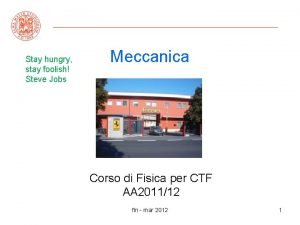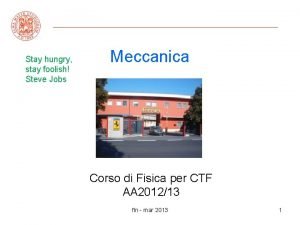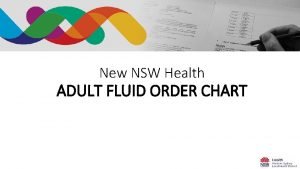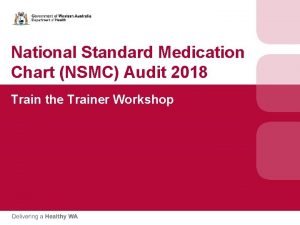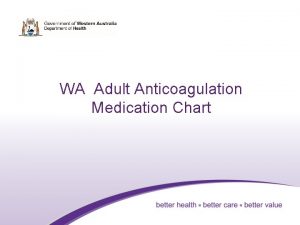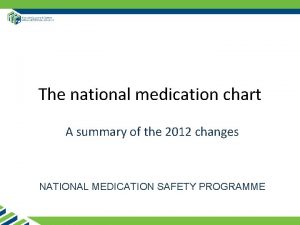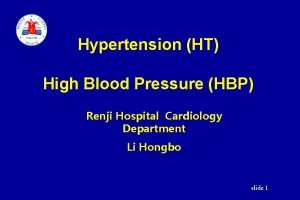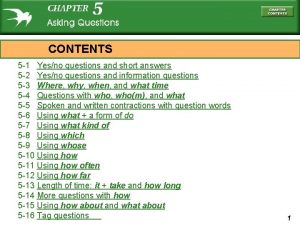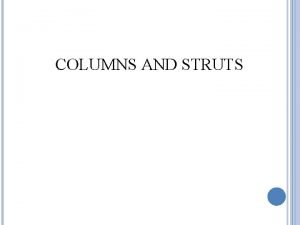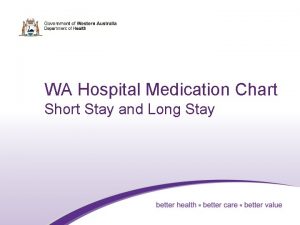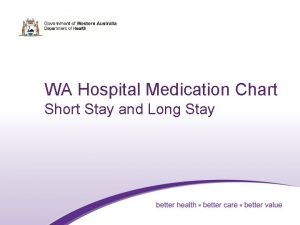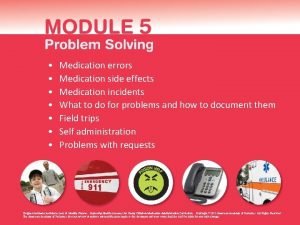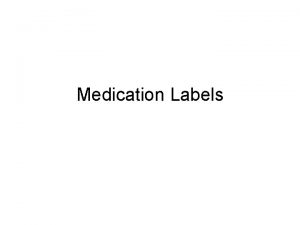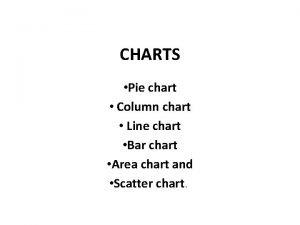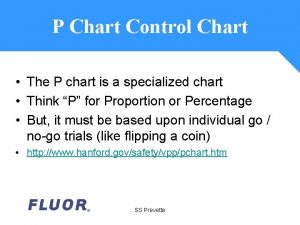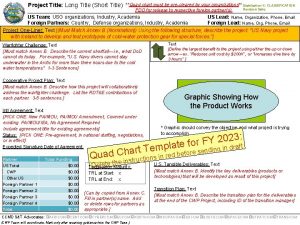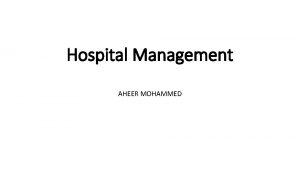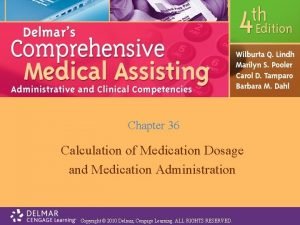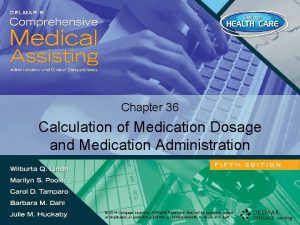WA Hospital Medication Chart Short Stay and Long


































- Slides: 34

WA Hospital Medication Chart Short Stay and Long Stay

WA Hospital Medication Chart (WA HMC) • The WA HMC is the national standardised medication chart designed to assist communication of a patient’s medication requirements consistently between health professionals and to support the safe and quality use of medications. • Use of the WA HMC is mandatory for all WA public and private health services that provide publicly-funded inpatient care. • The WA HMC – supports requirements for accreditation purposes – builds on the key safety features of the NIMC – has been modified to adopt the format requirements of the National Pharmaceutical Benefits Scheme Hospital Medication Chart (PBS HMC) 2

• Health Service Providers (HSPs) must use the WA HMC for adult patients (WA Medication Chart Policy) alongside the WA Health Electronic Discharge Summary application – currently Notification and Clinical Summary (Na. CS) • Use of the WA HMC for discharge dispensing remains at the discretion of the HSP but must not preclude the use of the Na. CS for discharge prescription. 3

Front page of WA HMC 4

Patient Identification • The patient’s identity must be established before prescribing commences. To ensure that the medications are prescribed for the correct patient, each medication chart must have: – The patient’s name, unique medical record number (UMRN), date of birth and gender written in legible print; OR – The current patient identification label (addressograph). Medications should not be administered if the prescriber has not documented the patient identification. 5

Patient Location & Number of Medication charts • The patient’s current location (ward or unit) within the hospital should be clearly marked on the medication chart. • If a patient moves to a different ward or unit, this new location should be indicated on the medication chart - the previous ward should be crossed off, and the new ward should be written in its place. • If there are more than one WA HMC or WA Paediatric NIMC in use, then this must be indicated by filling in the appropriate numbers in the space provided • If additional charts are written, or charts are ceased, this information should be updated 6

Additional (specialised) Charts • When additional (specialised) charts are written, this should be indicated by placing a tick or cross in the space provided for each specialised chart in use. Failure to communicate additional specialised charts may result in missed doses or duplicated prescribing. • There are two sections on the chart that can be used to document when specialised charts are in use. • Front of chart: • Inside chart above regular medication order: 7

Anticoagulant prescribing • Use of the WA Adult Anticoagulation Medication chart is mandatory for the prescription and administration of all anticoagulants • If an anticoagulant is prescribed in adults the anticoagulation specialised chart box on front of chart and the ‘Warfarin/Anticoagulant in use’ box should be ticked. • A “Patient on Anticoagulant” sticker may also be attached to the Warfarin/Anticoagulant in use box 8

Allergies and Adverse Drug Reaction Alert This section communicates the existence of previous allergies, adverse drug reactions (ADRs) and related information. The following details must be completed: • Allergy Status: • Tick the ‘Nil known’ box if the patient is not aware of any previous allergies or ADRs, OR • Tick the ‘Unknown’ box if no information is available about previous reactions (e. g. if the patient is unable to communicate), OR • Details of previous allergies or ADRs – include medication and reaction details (refer below for more information) • Signature and printed name of person taking allergy/ADR history • Date of initial documentation (by person above) Doctors, nurses, midwives and pharmacists are required to complete this documentation for ALL patients 9

Medicines Taken Prior to Presentation to Hospital • The admitting medical officer, pharmacist or other clinician trained in medication history documentation may complete this section. • This section is included on the medication chart to facilitate quick and effective documentation of, and access to, medication history information and provides space for the minimum information that should be documented. • For the majority of patients this information should be documented on the WA Medication History and Management Plan (WA MMP) form. 10

Once Only, Pre-Medication and Nurse/Midwife Initiated Medicines • The following must be documented in this section: – – – Date/Time prescribed Generic medication name Route of administration Dose to be administered Date/Time to be administered Prescriber’s signature and printed name OR nurse/midwife initiator’s signature and printed name – Initials of person that administered medication – Date/Time medication administered • Ward pharmacist should confirm the medication is safe to administer and annotate if the medication requires supply or is on imprest (I), a Schedule 8 (S 8) or Restricted Schedule 4 medication (S 4 R) 11

Telephone orders • Telephone orders are discouraged, as they are an error prone activity. To reduce the potential for error, telephone orders are to be countersigned by 2 nurses/midwives who have both independently heard/received and read back the order to the prescribing doctor • The following must be completed: Date/time prescribed Initial of two nurses/midwives to confirm Generic medication name Route of administration Dose to be administered Frequency at which the medication is to be administered that the verbal order has been heard and checked Name of doctor giving verbal order Initials of person that administers the medication Date and time medication administered 12

Middle Pages of the medication chart 13

Variable Dose Medicine Orders • This section has been formatted to facilitate ordering of medicines that require – variable dosing, based on laboratory test results (e. g. vancomycin) or – as a reducing protocol (e. g. prednisolone). • For each medication order, the following details must be documented: – Start date – Route of administration – Indication • For each dose, the following information must be documented: – – • - Generic medication name - Frequency of administration - Prescriber’s signature and printed name Dose to be administered Time dose is to be administered Prescriber’s signature Initials of nurse that administers the dose in ‘Nurse Initial’ box and notes actual time dose is given in same box. For each day of therapy, the following information must be documented: – Drug level results, when required – Time drug level taken 14

Regular Medicine Orders • All regular medications must be prescribed in this section of the WA HMC • For an order to be valid the following must be complete • • • Start date Generic medicine name Route of administration Dose and Frequency Indication Prescriber’s signature and name (printed) 15

Slow Release box • The “Tick if Slow Release” box is included as a prompt to prescribers to consider whether or not the standard release form of the medication is required. This box must be ticked to indicate a sustained or modified release form of an oral medication (e. g. verapamil SR, diltiazem CD, metformin XR, tramadol SR). • If not ticked, then it is assumed that the standard release form is to be administered. • If the box has not been ticked, nursing staff may want to contact the ward/clinical pharmacist or prescriber to seek clarification of which form should be administered to the patient. 16

Limited Duration or Intermittent Doses • When a medication is ordered for a limited duration, this must be clearly indicated. The days or times when a medication is NOT to be given may be indicated by crosses (X) or a line through the appropriate administration day/time box. • When a medication is ordered only on certain days, this must be clearly indicated by documenting the day of administration as part of the prescription order (i. e. stipulate Monday if that is the day the medication is to be taken). • The medication order must clearly distinguish between when the medication is to be administered, and when it is not to be given. 17

Ceased or changing medicines • When ceasing a medication, the original prescription must NOT be removed or obscured. • The prescriber must draw a clear diagonal line though the order and two diagonal lines through the administration record section • Prescriber must write ‘ceased’, reason for ceasing, date and sign the ceased order. • If a change to the medication order is required the above should be followed and complete a new entry on the chart 18

Administration Record • Every nurse/midwife has a responsibility to ensure they can clearly read and understand the order before administering any medications. For all incomplete or unclear (include illegible) orders, the prescriber must be contacted to clarify. • Assumptions should never be made about the prescriber’s intent. • Remember the six Rights – – – The right patient The right medication The right dose The right time The right route The right documentation 19

Reasons for Not Administering • When it is not possible to administer the prescribed medication, the reason for not administering must be recorded by entering the appropriate code and circling this code. • By circling the code, it will not accidentally be misread as someone’s initials. • The nurse/midwife is responsible for obtaining supply of a medication that is not available on the ward by contacting pharmacy • The prescriber must be notified : – If a patient refuses a dose – If the medication is not available on the ward • If a medication or dose is withheld, the reason must be documented in the patient’s medical notes. 20

Pharmaceutical Review • The clinical/ward pharmacist (or appropriately credentialed health professional for medication review) must sign this section as a record that they have reviewed the medication chart on that day • Review by a clinical pharmacist will ensure that all orders are clear, safe and appropriate for that individual patient, therefore the risk of an adverse drug event is minimised 21

Back Page of Medication Chart 22

As required (PRN) Medicines • Prescribing section must have the following complete: – – – Start date of prescription Generic medicine name Route of administration Dose and hourly frequency Indication and maximum daily dose Prescriber’s signature, printed name and contact details • Administration section the following must be documented: – – – Date Time Dose administered Route of administration Initial of person administering the dose • Person checking each dose is responsible for – Checking maximum daily dose is not exceeded – Checking the timing of the previous dose 23

Multiple route orders • Generally, medication orders should be written for ONE ROUTE only. • Local requirements may indicate other practices. • Hospital and health service organisations should be aware of risks associated with medication orders with multiple routes of administration. • A health service-specific list of exceptions to the general rule should be determined in conjunction with the health service’s Drug and Therapeutics Committee (DTC) or equivalent, and appropriate risk mitigation strategies put in place 24

Special features of WA Paediatric NIMC • The paediatric versions (both short stay and long stay versions) incorporate additional features identified as important for facilitating safe medications use in the paediatric and neonatal populations. – Boxes for recording weight and date measured on front and back pages – Spaces for recording body surface area (BSA) and gestational age at birth (where relevant) 25

Special features of WA Paediatric NIMC • Space for documenting the basis of dose calculation (e. g. mg/kg/dose) • Space for double signing when recording administration 26

Special features of WA Paediatric NIMC • Reason for Not Administering: – There is an additional code on the paediatric NIMC – This code indicates that the medication was administered by the paediatric patient’s parent or carer 27

Transdermal Patch Check Sticker • The transdermal patch check sticker (“the sticker”) was developed to prompt nursing staff to check that: – the prescribed medication patch is securely intact on the patient’s body, and – the correct medication patch is in situ at each shift, and – the correct strength patch is in situ at each shift. • This sticker may be used for all medication patches that remain in situ for greater than 24 hours • For further information please refer to the WA HMC user guide 28

Ordering and administrating miscellaneous products on the WA HMC • The WA HMC or WA Paediatric NIMC is not designed for ordering and recording administration of nutritional supplements (oral or enteral). • Some health services have a separate clinical nutrition chart for ordering and administering these products. • Health Services that choose to use the WA HMC for ordering nutritional supplements should undertake a risk assessment and have a local policy or procedure on the ordering and recording administration of nutritional supplements. • The WA HMC should not be used to order or administer medical gases such as oxygen, as these medications require specific features to safely order, administer and monitor their use. 29

Discharge Supply • Use of the WA HMC for discharge dispensing remains at the discretion of the HSP. • It must not preclude the use of the WA Electronic Discharge Summary Application (currently Na. CS) for discharge reconciliation, prescription generation requirements at discharge, creation of consumer medication lists and discharge summaries 30

Discharge Supply • Private contracted health entities that provide publicly-funded inpatient care must implement this chart for PBS inpatient and discharge supply. • All approved PBS prescribers in accordance with local policy can use the WA HMC to prescribe eligible PBS/RPBS medications. • An Approved Medical Practitioner cannot supply medications from a WA HMC. • Supply from the WA HMC will occur at the pharmacy service attached to the hospital by whatever arrangement is in place. • If a patient is discharged outside of normal pharmacy service business hours, a separate PBS/RPBS prescription will need to be prepared in this instance by the PBS prescriber discharging the patient. 31

PBS requirements Prescribers should ensure that each medicine panel is completed in full. – Write clearly in blue or black indelible pen (ball point pens only) – Write the word ‘private’ or ‘non-PBS’ where you do not intend a PBS or RPBS claim to be made – Tick the brand substitution box if any or all of the medicines on the PBS HMC are not suitable for generic substation – emphasise your instruction by specifying the brand name in each applicable medicine order – Mark the appropriate ‘valid for’ period on the front of the chart (1, 4 or 12 months) and initial. – Refer to the User Guide for further information on the best practice use of the PBS HMC. – Prescribers must ensure that medicines are prescribed on the PBS HMC in accordance with jurisdictional regulations. 32

PBS requirements • The Hospital Provider number is a PBS /RPBS requirement for hospitals using the WA HMC for discharge prescriptions. • Chart Validity – Is only required to be completed if the hospital is using the WA HMC for PBS claiming of discharge prescriptions • Prescriber Details – For a valid PBS prescription this section MUST be completed 33

PBS requirements • SAC/AAN • Streamline Authority Code (SAC) – is the relevant 4 digit streamline code. Only the prescriber can provide this information • Phone authority – a single PBS authority prescription number is printed on the WA HMC and must be used by the prescriber to obtain authority approval • Authority Approval Number (ANN) –must be written in the box provided. Only the prescriber can provide this information. 34
 Long and short
Long and short Wa anticoagulation chart
Wa anticoagulation chart Rascal flatts my wish
Rascal flatts my wish Where you go i'll go where you stay i'll stay
Where you go i'll go where you stay i'll stay What does stay hungry stay foolish mean
What does stay hungry stay foolish mean In the afternoon i stay home
In the afternoon i stay home So stay so stay 再知己
So stay so stay 再知己 Robert herrick to daffodils
Robert herrick to daffodils Stay tuned stay foolish
Stay tuned stay foolish Good morning with stay safe
Good morning with stay safe Stay hungry stay foolish significato
Stay hungry stay foolish significato Once upon a time there lived an old man with his wife
Once upon a time there lived an old man with his wife Define hospital
Define hospital Menstrual cycle in dogs
Menstrual cycle in dogs Dog periods
Dog periods Iv fluids types chart
Iv fluids types chart Nsmc chart
Nsmc chart Heparin drip protocol
Heparin drip protocol National medication chart nz
National medication chart nz Antihypertensive drugs classification
Antihypertensive drugs classification Tinikling costume and props
Tinikling costume and props Greek
Greek Short run equilibrium under perfect competition
Short run equilibrium under perfect competition 369 times 2
369 times 2 What is a semiconductor used for
What is a semiconductor used for Long medium and short term planning in primary schools
Long medium and short term planning in primary schools Long case vs short case
Long case vs short case Short term and long term human resource planning
Short term and long term human resource planning Difference between short hedge and long hedge
Difference between short hedge and long hedge Difference between long term and short term liabilities
Difference between long term and short term liabilities Key terms for division
Key terms for division Yes-no questions and short answers
Yes-no questions and short answers Long column and short column slenderness ratio
Long column and short column slenderness ratio Difference between long term and short term liabilities
Difference between long term and short term liabilities Long run market supply curve
Long run market supply curve








